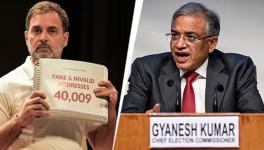Bihar: Ni-Mo Double Engine Leaves State Finances in Mess
Image use only for representational.
Prime Minister Modi described his and Bihar Chief Minister Nitish Kumar’s alliance as a ‘double engine’ that would drive the state to prosperity. But a look at the state’s finances shows a tragic picture of incompetence and neglect. This is all the more shocking because Bihar has been long suffering from endemic poverty and under-development, and both Modi and Nitish Kumar have been promising a golden dream for some years.
The first and most striking symptom of this sorry state of affairs is that the state boasts of a revenue surplus, which is increasing steadily, according to data published by the Reserve Bank of India. [See chart below] This means that the state is earning more than it is spending – year after year. Last year, for example, the revenue surplus was a whopping Rs 21,517 crore.
For one of the poorest states in the country, largely based on agriculture, with high degrees of hunger, illiteracy, chronic disease prevalence and low levels of industrialisation, it is bizarre that an administration is unable to find ways to spend the money it has raised.
Some other poorer states in the country too run a revenue surplus – it seems to be a characteristic of under-development, or perhaps bankruptcy of policy making. The money is there, but the state government is just unable to spend it.
Falling Own-Tax Revenues
Meanwhile, another facet of this dire situation is that the share of the state’s own tax revenue to total revenue has been falling since 2013-14. [See chart below] In 2019-20, this share had dropped to just 20% which is the same as it was 15 years ago when Nitish Kumar took over as chief minister. At its peak in 2013-14, the share had risen to 29%.
State governments raise revenues through several taxes and duties they decide to levy. These include taxes on income (like those on professionals), taxes on property (like land, stamps and registration fees), taxes on goods and services (like sales tax, excise, transport, entertainment, State GST etc.). Then, they have statutory receipt of shares from central taxes.
In most states, the imposition of GST by the Modi government in 2017 has led to a fall in own tax revenue. This was partly compensated for by the cess that the central government levies for the purpose.
Also read: Nitish’s Prohibition Policy: A Horror Worse than Emergency
But the declining own-tax revenue in Bihar represents a bigger problem – in the absence of industry and modern services sector, and a low level of economic development, tax generation itself is low. This was always a problem, but under the double engine’s aegis, it has worsened remarkably.
As a result of this sorry state of affairs, the Bihar government under Nitish Kumar has gone on a borrowing spree with outstanding liabilities now amounting to Rs 1.86 lakh crore, up by 71% in the past five years.
People Bear the Burden
The effect of this mismanagement and paralysis displayed by the JDU-BJP government is that key areas that needed intensive intervention by the government have continued to languish. Medical and public health spending has remained stagnant at around 4% of the total revenue expenditure leading to the present shambles highlighted by the pandemic. Water supply and sanitation – something that Nitish Kumar is promising afresh in this election campaign – has been getting only about 1% of total spending ever since 2005 when Nitish became a chief minister. It is only in the last three years that spending on this crucial sector has slightly increased to about 4%.
The JDU-BJP combine has portrayed itself as the messiah of extremely backward classes (EBCs) and ‘mahadalits’ but a look at the spending on welfare of Dalits and Adivasis shows that it stagnated at around 1% of total spending for the first five years, rose to about 4% average in the next five years and has since dipped to about 2% in the last five years.
With widespread hunger and malnutrition, especially among children and infants, it would be expected that the Bihar government would spend some more money on providing essential nutrition to the most needy sections. However, spending on nutrition has hovered around 1-2% all through the JDU-BJP rule of the past 15 years.
With this kind of indifference and neglect, ‘Sushasan Babu’ (Good governance man) as Nitish likes to style himself has turned out to be a complete failure. And, BJP has been with him all along in this decline and fall.
Also read: Bihar Elections: Each Voter Owes Over Rs 25,000, Thanks to JDU-BJP Govt’s Incompetence
Get the latest reports & analysis with people's perspective on Protests, movements & deep analytical videos, discussions of the current affairs in your Telegram app. Subscribe to NewsClick's Telegram channel & get Real-Time updates on stories, as they get published on our website.
























